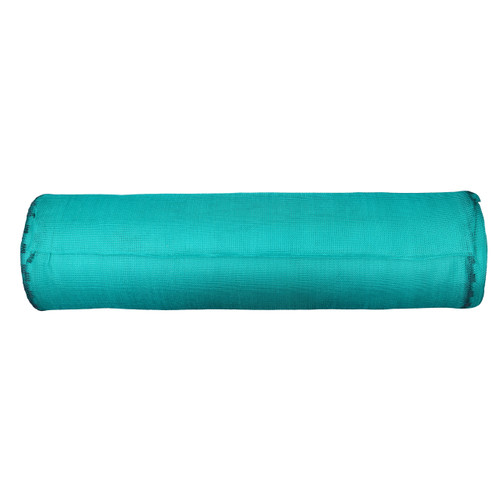-

 Supplied as a single roll Colour: Green, Black & Blue Spec: 50gsm Usage: Scaffolding, heras fencing, partitioning, gardening and allotments Tarpaflex debris netting is manufactured to approx. 50gsm. All of our netting has button hole eyelets...£15.42 - £47.40 (Inc. VAT)£12.85 - £39.50 (Ex. VAT)
Supplied as a single roll Colour: Green, Black & Blue Spec: 50gsm Usage: Scaffolding, heras fencing, partitioning, gardening and allotments Tarpaflex debris netting is manufactured to approx. 50gsm. All of our netting has button hole eyelets...£15.42 - £47.40 (Inc. VAT)£12.85 - £39.50 (Ex. VAT) -

 Supplied as a single roll.This flame retardant netting is manufactured to the US standard CPAI 84, Section 6. Size: 2m x 50m Colour: White Spec: 60gsm Approx Weight : 6kg Coverage : 100 Square Metres£41.58 (Inc. VAT)£34.65 (Ex. VAT)
Supplied as a single roll.This flame retardant netting is manufactured to the US standard CPAI 84, Section 6. Size: 2m x 50m Colour: White Spec: 60gsm Approx Weight : 6kg Coverage : 100 Square Metres£41.58 (Inc. VAT)£34.65 (Ex. VAT) -

 Supplied as a single roll Tarpaflex debris netting is manufactured to approx. 70gsm. All of our netting has knitted button hole eyelets along the edges and through the middle, to ease fixing of netting to scaffolding or other objects. Due to the size of...£33.06 - £51.59 (Inc. VAT)£27.55 - £42.99 (Ex. VAT)
Supplied as a single roll Tarpaflex debris netting is manufactured to approx. 70gsm. All of our netting has knitted button hole eyelets along the edges and through the middle, to ease fixing of netting to scaffolding or other objects. Due to the size of...£33.06 - £51.59 (Inc. VAT)£27.55 - £42.99 (Ex. VAT) -

 Tarpaflex heavy duty debris netting is available in 100gsm (grey) and 150gsm (green). All of our netting has button hole eyelets along the edges and along the middle section, to ease the fixing of the netting to scaffolding or other objects.£62.58 - £103.90 (Inc. VAT)£52.15 - £86.58 (Ex. VAT)
Tarpaflex heavy duty debris netting is available in 100gsm (grey) and 150gsm (green). All of our netting has button hole eyelets along the edges and along the middle section, to ease the fixing of the netting to scaffolding or other objects.£62.58 - £103.90 (Inc. VAT)£52.15 - £86.58 (Ex. VAT)
Frequently Asked Questions
What type of netting is strongest?
The strongest netting for outdoor use is typically heavy duty netting, designed to withstand exposure to the elements. For gardens, heavy duty debris netting offers superior durability, providing protection against wind, birds, and pests. For construction, 100gsm or 150gsm debris netting is the most robust option, capable of containing debris and resisting tearing under strain.
What can I use to hold up garden netting?
To effectively secure garden netting, you can use:
Metal or plastic stakes: Ideal for creating a frame to elevate the netting over plants.
Cable ties: Suitable for fastening the netting to fences or stakes for a secure, long-term hold.
Shock cords: Perfect for temporary or adjustable installations, allowing you to easily remove or reposition the netting.
Clips or pegs: Handy for pinning netting to the ground or fixing it around raised beds.
What is the purpose of debris netting?
The primary purpose of debris netting is to enhance safety on construction sites by containing loose materials and preventing them from falling. However, it also serves additional functions, including:
Wind reduction: Minimises the force of wind on scaffolding, creating a safer working environment.
Dust control: Helps reduce the spread of dust and airborne particles.
Garden protection: When used as heavy duty netting for gardens, it shields plants from wind damage and deters birds and pests.
How long does debris netting last?
The lifespan of debris netting depends on its quality, usage, and exposure to the elements. Standard debris netting typically lasts 1-2 years with regular outdoor use, making it suitable for short-term projects or temporary garden protection. In contrast, heavy duty netting can last 3-5 years due to its thicker, more durable construction, making it ideal for long-term applications such as garden enclosures or construction sites. To maximise its lifespan, it’s best to store the netting properly when not in use and avoid prolonged exposure to harsh UV rays, which can weaken the material over time.
What is the difference between a safety net and a debris net?
While both safety nets and debris nets are commonly used on construction sites, they serve different purposes. Safety nets are designed to catch and support people in the event of a fall, providing vital fall protection for workers. Made from high-tensile material, they comply with strict safety standards and are capable of withstanding substantial impact forces.
In contrast, debris nets are intended to contain falling objects, such as tools, rubble, or building materials, preventing them from leaving the work area. Their purpose is to enhance site safety by reducing the risk of debris-related accidents. However, debris nets are not designed to protect against falls and should not be used as a substitute for safety nets.
How strong is debris netting?
Debris netting is highly durable and designed to withstand significant force, making it suitable for both construction and garden protection. Standard debris netting (50gsm or 70gsm) offers good strength for light-duty applications, such as protecting plants or containing small debris.
For more demanding tasks, heavy duty debris netting (100gsm or 150gsm) provides greater tear resistance, making it ideal for construction sites or long-term garden protection. The mesh size and density also influence its strength - smaller mesh sizes offer better resistance to tearing and improved containment of fine debris or wind-driven particles.



